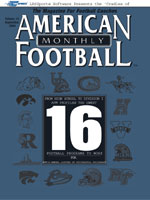AMERICAN FOOTBALL MONTHLY THE #1 RESOURCE FOR FOOTBALL COACHES
Article CategoriesAFM Magazine
|
Trojan PrideUSC\'s Pete Carroll Finds a True Homeby: Jeff Davis © More from this issue It’s clear to me that I want to put together a program that can win on a consistent basis and compete for championships year in and year out. This is a grand opportunity here,” a proud Pete Carroll said early this summer during a break at his football camp on the University of Southern California campus in Los Angeles. “USC has all the elements you need for a championship program.” Coach Carroll can’t wait to unleash his fourth edition of the Trojans to see how they run and how they pass in Norm Chow’s exciting, productive offense and how they stifle opponents in his own smothering defense. With virtually everybody back from last season’s national co-champions, and ready replacements in place for the have- departed, USC is the 2004 pre-s....The full article can only be seen by subscribers. Subscribe today!
|
|
|||||||
| HOME |
MAGAZINE |
SUBSCRIBE | ONLINE COLUMNISTS | COACHING VIDEOS |
Copyright 2025, AmericanFootballMonthly.com
All Rights Reserved





